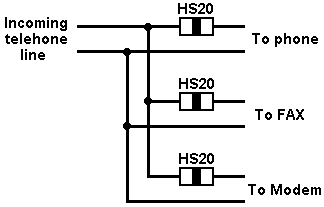


This circuit uses three HS20s, bilateral silicon trigger switches, to form a phone-line privacy circuit. This circuit prevents a second phone, fax, or modem from picking up the line if one device is already using the line. The HS20 prevents current from flowing until the voltage has built up to a definite, repeatable value, then fires (or begins conducting). With the phone, modem, and fax on-hook, 30 to 50 volts DC is standing on the line. If, say, the modem goes off-hook, it closes the loop,and the HS20 sees the 30 to 50 volts across it. Because the HS20 is manufactured to trigger at 20 volts, it triggers, and becomes a very low resistance (about a 2 volt drop) part of the loop circuit. Should the other phone(s) (or phone type devices) in the circuit now try to access the line, nothing will happen. The voltage on the circuit, with the modem accessing the line, has dropped to somewhere between 6 and 18 volts. This voltage is not enough to fire the trigger switch at the phone's site, and the HS20 remains in a high-impedance (resistance) state. This circuit can be used to stop interruptions on a modem connection. The HS20 is manufactured by Teccor Electronics.
Source: "Electronics Now" Magazine, May,96 issue (C) Copyright Gernsback Publications, Inc., 1996
Home | Product Info | Ordering Info | Contact Us | Get a Demo
Circuits in CyberCircuit | Circuits in CyberCircuit Plus | Circuit du Jour | Circuit Archive
Copyright (c) 1995-1998 by PTM